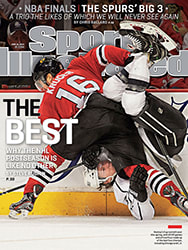
The Case for ... Batting Your Stud Second
Babe Ruth wore his iconic number 3 because when the Yankees first assigned uniform numbers, in 1929, they did so based on a player's lineup spot. Ruth batted third, because the fashionable thinking of the time was that the best player bats third. Other fashionable thinking from the late Jazz Age held that it was a good idea to smoke like a chimney while traveling by train no farther than St. Louis to play all-white baseball games.
We know better now. Mostly. Because while a diverse Reds squad jets coast-to-coast on nonsmoking flights, they're still batting their best hitter third—and it's costing them runs. Joey Votto is the game's greatest offensive force, with an absurd .469 OBP since the start of 2012. He's at .460 this year, including. 492 in May. Cincinnati's two hole (usually occupied by shortstop Zack Cozart) has a .246/.271/.382 line in '13, but every day Dusty Baker sets a lineup that places a weak hitter ahead of his best player.
It doesn't have to be this way. The best modern analysis of lineup order—as published in The Book, by Tom Tango, Mitchel Lichtman and Andy Dolphin—points to one conclusion: a team's best hitter should bat second. Doing so clusters the best hitters more efficiently, putting more runners on base for the big sticks in the middle of the lineup. But most significant, it gets the best hitter more at bats. Each lineup spot gets about 18 extra plate appearances a season more than the spot below it, so moving up a Votto is like squeezing four extra games a year out of him, while taking those games away from a player with a .271 OBP.
This idea is starting to get some traction within the game. The Phillies' Chase Utley, a fixture in the three hole, and Robinson Cano, the Yankees' cleanup hitter much of last season, have spent time in the second spot this year. John Gibbons moved Jose Bautista to the two hole two weeks ago and has seen his Blue Jays average 5.56 runs a game since. In Minnesota, Joe Mauer—roughly the AL's version of Votto, a high-average, high-OBP lefty—has batted second in 46 of his 51 starts this season.
Getting that best player up three extra times a month sounds trivial, but now and again it could be the difference between winning and losing. On May 17 the Reds, down 5--3 to the Phillies in the ninth, had a runner on second with two outs. Instead of having Votto up as the tying run, they had him in the on-deck circle, watching Cozart pop up to end the game. That wasn't a new phenomenon; four times last year Cincinnati had a ninth-inning rally in a close game end with Votto watching a vastly inferior hitter make the final out.
In addition to getting more plate appearances, Votto would also get more chances to actually swing the bat hitting second. He leads the NL in intentional walks, with nine, after topping the league last year with 18. Three this year have come after a sacrifice bunt opened up first base for the opposing manager. Batting Votto directly behind leadoff man Shin-Soo Choo will eliminate those bunts (a good idea in itself, but that's an argument for another day) and put Votto at the plate with first base occupied more often. You protect great hitters not by worrying about who bats behind them but by having the bases occupied when they come to the plate.
The tactical giveaway of batting two lefties consecutively is a concern, but it's not as if having Cozart or Cesar Izturis or even Brandon Phillips batting between Choo and Votto is going to dissuade managers from bringing a southpaw into the game late. Moreover, the practice of automatically using the closer in the ninth inning means that the opposing manager will usually elect to face Choo and Votto with a righthander in the final frame, anyway, rather than get away from his assigned bullpen roles.
This is one of those ideas that seems a lot more radical than it is. "Give your best hitter more at bats at the expense of a lesser one" shouldn't be that hard a sell, but the most powerful force in baseball isn't Miguel Cabrera—it's inertia. The argument that we've always done it this way is not enough anymore. Joey Votto should be batting second for the Reds.
Follow @joe_sheehan
Moving Joey Votto up in the lineup is like squeezing four extra games a year out of him.
PHOTO
TOM DIPACE

